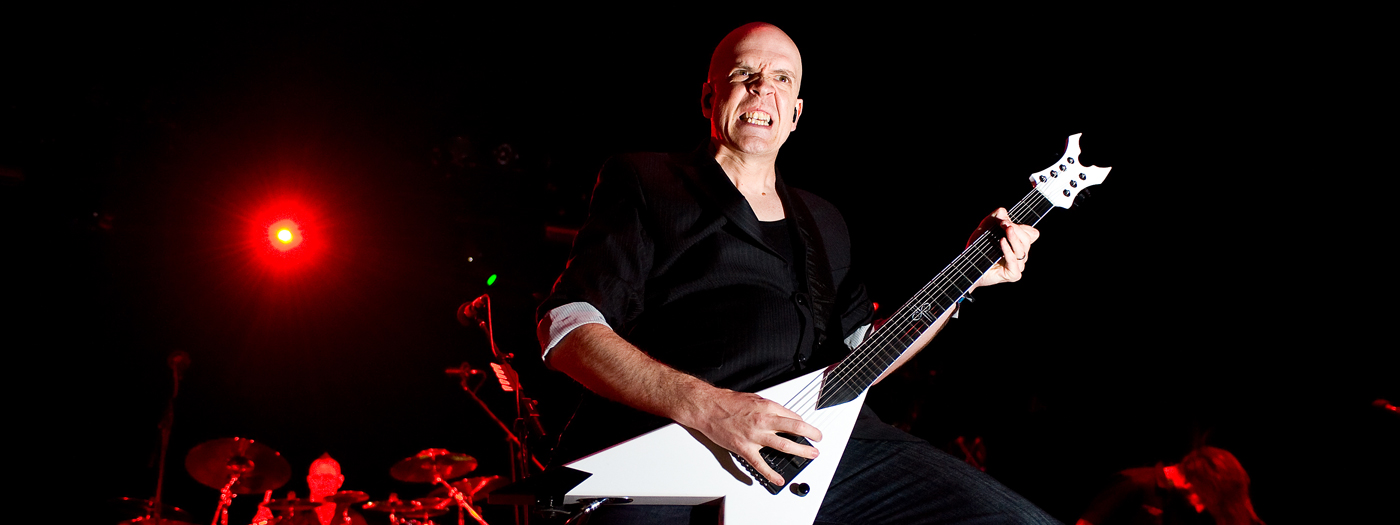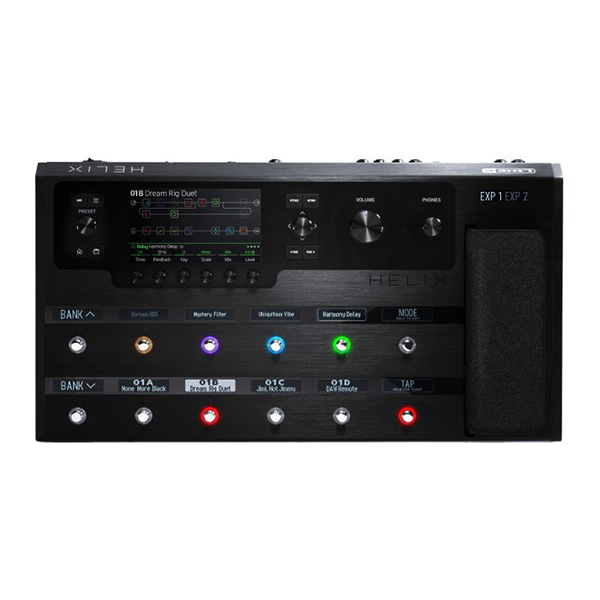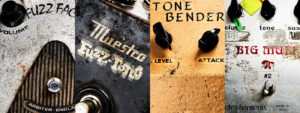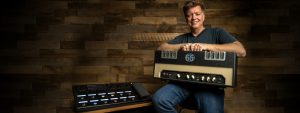Devin Townsend – From Extreme Metal to Ambient Explorations with Helix
by James Volpe Rotondi
Devin Townsend’s introduction to the broader public came when the fiery and almost feral-looking 21-year-old phenom was drafted to be the lead singer on Steve Vai’s controversial Sex & Religion album in 1993. Two years later, Townsend established himself as a leader with the critically acclaimed City album by his extreme metal band Strapping Young Lad. Throughout the subsequent years the highly prolific and profoundly gifted guitarist, keyboardist, songwriter, singer, engineer, and producer has explored numerous genres on dozens of recordings—from heavy metal to progressive pop to new age. Lightwork, released in 2022, offers Townsend’s now familiar signature blend of those seemingly disparate elements, presented via he and co-producer GGGarth’s meticulously layered wall of sound-style production.
Townsend’s extreme metal origins and lifestyle notwithstanding, the 51-year-old Vancouver-based auteur replaced his former diet of alcohol and psychedelics with sobriety, vegetarianism, and daily meditation long ago. While diving deeper into the calming currents of ambient music, which he both listens to religiously and creates assiduously, Townsend has in recent years turned exclusively to the powerful sound engines in the Helix amp and effects processor as the primary palette for the expansive, searching sound of albums such as 2021’s The Puzzle and Snuggles.
That said, Townsend welcomes motivation anywhere he can get it. “I think fear is a fantastic motivator,” he laughs. “You’ve got kids and you’re in the music biz in 2023? Trust me, panic is great for getting stuff done!”
Preparing for an interview with you is a bit daunting, as there are just so many albums to consider. You mentioned the necessity of supporting your family, but it seems like you have been driven this way for quite some time.
Well, I do think that a lot of the past 15 years or so have been motivated by a relentless need to provide well for the kids. But deeper than that, the stuff that I’ve written and produced that I think is really worthwhile typically comes from a place of being compelled to do it. Just last night, for example, I had no intention of writing music at all, but then this budding idea suddenly grabbed hold of my thoughts, and it just seemed appropriate to follow that voice.
It’s that mechanism, that inner voice that calls you to complete an idea, that is of the greatest value to me. And so, while my circumstances have changed, the objectives have been more or less the same since the beginning, and I can trace that back to when I was six years old. At any given time, I’m trying to hone a particular vision, so that each album becomes a sort of essay of my life during that particular period. It’s that old metaphor of the carrot on the stick. Which I guess means I’m the … donkey, right? [Laughs.]
The Devin Townsend Project performing “Deadhead”live at Royal Albert Hall in 2015.
Your albums also tend to be quite ambitious, layered, heavily arranged. I often wonder how you get players who’ll attach themselves to the task of unpacking this rather complex material, which clearly cannot be fudged. There’s got to be serious work involved in recreating this stuff live.
Oh, dude, it’s so ambitious, and of course I can’t afford to have choirs and orchestras all the time, so over the years I’ve just ended up learning how to do most of it myself—learning how to do the production, the engineering, the singing, the keyboards, the bass. Man, I’ll do whatever I need to do in order to get this music from point A to point B. Happily, right now I’ve got a core group of players around me that I can trust, and I’m self-sufficient enough to do it myself if I need to.
Does that ever lead to uncomfortable dynamics with the players, who really need to fall in line with your very clear ideas on how you want things executed?
Absolutely. The social interactions are a huge part of this work, how you relate to other people and how you navigate these relationships with band members. It’s really difficult sometimes to manage that side of it when I know exactly what I want. The best course for me—and I’ve known this since I was as young as I can remember—is to try not to hurt people, but to still follow that vision with some intensity. That’s why I’ve often ended up doing everything myself. I don’t want to be a tyrant about it. I certainly don’t want to be a diva about it. But I always know what it is that I want to accomplish. My work ethic is so relentless that oftentimes I’ll end up working with people for a brief time before realizing that it’s just not going to work out. Having said that, I do believe that the primary function of both life and music is learning how to connect with people, because in absence of that, there are no resonant qualities to the work.
The word “resonance” is a good place to begin discussing the sounds you create using Helix. Am I correct that your principal passion with Helix is using it for your ambient music?
Yes, that’s right, though it’s worth mentioning that I go way back with Line 6 equipment. I started in the 1990s with the famous red kidney bean-shaped POD, then the POD XT. When I started working with Line 6 in a more official capacity, though, was when I started using their wireless units on tour, which then led to me using Line 6 amps, as well, like the AMPLIFi 75 and AMPLIFi 30, both of which I’ve beaten to hell on tour for at least the past ten years. I’ve also got a ton of use out of the Line 6 Firehawk FX. But around 2017, I stumbled upon this incredible loop preset with a clean delay in Helix and I’ve used it ever since, on every album, especially for writing, and in particular as a sort of foundation for all the ambient guitar work that I do.
Apart from the quality of the sonics, was there anything else about Helix that inspired you?
Definitely. Oftentimes with gear, when you get to the editing process the controls don’t quite do what you expected them to do, so you keep getting thrown out of the creative mindset into a draggy technical one. As I was working with Helix, I began to notice that every time I hoped a particular control would do what I wanted it do, it actually did it. This told me that Helix was made by musicians who were passionate about getting it right. With the Helix Floor, I was able to really get out of my own way while creating sounds, which implied that the engineering department thought through every control parameter so it that was intuitive and musician friendly. That was super-inspiring to me, and that’s why Helix Floor became the key piece of gear in the ambient guitar work that I do, and why it’s now so integral to my creative process.

How do you configure Helix Floor for ambient recording and live shows?
To set the scene: I sit on the floor, almost meditation-style when I do this, and I’ve actually got two Helix Floors set up—one on either side of me, with an ABY box between them. One of the Helix Floors is slightly panned left, and the other one is slightly panned to the right. Mind you, they’re both doing full stereo, it’s just that one of them is slightly more focused left, and the other to the right. The first Helix is mostly for subby sounds and bass sounds and the other one is mainly for “floating guitar” and midrange- and higher-frequency guitar synth models. I then simply set up the Helix loopers in a way that allows me to spontaneously create these lush pads and textures, then improvise over them.
I know that you’d rather not give away too many details about this, but could you provide an example of the kinds of signal chain you might use in a given ambient preset?
Let’s see. Okay, I’ve just called up this particular preset. It starts with an Autoswell and then goes into a compressor, a Vintage Swell delay, and a Fender-style clean amp. Then I’ve got the Growler and sub synths in the top chain, followed by the Transistor Tape Delay and the Shimmer reverb. From there the signal passes through a String Theory synth, another low synth, and into a looper. After that, there’s Digital delay into a Heliosphere delay and another Vintage Swell delay, with a tremolo set to square wave modulation at the end of the chain. The tremolo is controlled by the expression pedal on the Helix, which I use to fade it in and out. I love being able to combine all these different types of effects with the intent of creating massive clouds of sound.
Close listening reveals a lot of stacked delays, indeed. Those are some very cool and nuanced sounds.
I guess what I’m looking for with delays is more of a sustain rather than a tangible ding-ding-ding sound, y’know? I’m looking for more of a beautiful smear. With these stacked effects, the trick is finding ways for the frequencies in the top and low ends to interact with my dry signal so it doesn’t muddy it up too much, and for the echo repeats to interact with each other so that it doesn’t sound like M&Ms being thrown at a steel wall. [Laughs.] The best way for me to describe it is that I’m looking for a “pad” sound rather than an obvious echo. And I should mention that my dry guitar sound is generally nowhere to be found in most of these Helix presets.
Interesting. Still, I feel like I can definitely hear the “Fender-ness” of many of these sounds.
Well, when using Fender-style amp models with my delay chain in that scenario, I will generally lean toward analog delay—something that has got a lot of roll-off on the top end and that nice bit of modulation that I can then send into a long reverb, perhaps a hall reverb that is maybe set to about 30% of what that first delay is set to. It adds a “tail” to the delay repeats, while hitting it at about the same volume. From there, I’ll often go into a ping-pong delay that also kind of attenuates the high and low ends. This creates something like the effect of a reverb, but without some of those frequency spikes that come with the density of a reverb. It eliminates that kind of bloom in that low midrange that a reverb would typically give you in that application.
“The Puzzle” from The Puzzle.
My sense of you is that you are a kind of futurist. While many of us feel this need to hang on to the kind of vintage guitars and tones and approaches we grew up with, you seem completely unafraid to fly into the future of sound, to keep asking “What if”? Is that fair?
I’ve got a buddy who’s extremely disparaging about technology, and his go-to line is always, “Well, the Beatles didn’t need that.” And my answer is always, “Dude, they didn’t have that.” If they’d had this technology with the extremely forward-thinking nature of what they were doing at the time, how can you imagine for a second that they wouldn’t have utilized it? It’s absurd. People often doggedly hold onto the aesthetics of gear that they love because it’s got much more to do with their memories of it than it does with any sort of practical, contemporary application. It’s easy to be a purist about amplifiers and guitars if it’s got some emotional connection to your childhood.
For me, what it really comes down to is do you like the sound you’re getting right now? And if you do, there you go. If you don’t, then you can identify what it is that you don’t like about it, and then start to deconstruct that. But it’s no good to start from a place of trying to avoid doing things wrong. Instead, try going into the creative process with an almost child-like mind, with an attitude of “Let’s just have some fun with this.”
Going back to the Helix, that’s the thing I love about it: it’s freaking fun! At first that may sound like a sort of condescending compliment, as if Helix is some kind of toy. I can assure you, it’s definitely not a toy. But what we’re trying to do in the creative process is to get out of our own way, get out of the way of our judgments and preconceptions, so that we can play guitar with a certain sense of freedom and joy. So, yeah, if I’m going to play with a piece of equipment, I absolutely want it to be fun. That’s it.
Main photo: Will Ireland/Getty Images
Live photo: Christian Bertrand

Guitarist and writer James Rotondi has been a Senior Editor at Guitar Player and Guitar World, a contributor to Rolling Stone, JazzTimes, Acoustic Guitar, Mojo, and Spin, and has toured with the acclaimed bands Mr. Bungle, Humble Pie, and French electro-rock group Air. He currently performs over 140 dates a year channeling Jimmy Page for the acclaimed Led Zeppelin tribute band ZOSO. He lives in Nashville.
Related posts
By submitting your details you are giving Yamaha Guitar Group informed consent to send you a video series on the Line 6 HX Stomp. We will only send you relevant information. We will never sell your information to any third parties. You can, of course, unsubscribe at any time. View our full privacy policy






Leave a Reply
You must be logged in to post a comment.